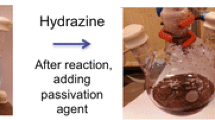Abstract
Copper paste is poised to replace silver paste in some applications because of its low cost. However, a high temperature (>900 °C) is required for sintering a film printed with a copper micro-flakes paste, while film cracking might occur if the paste is made up of copper nanoparticles. In this study, these problems are ameliorated by using a mixture of copper micro-flakes and nanoparticles in the paste. The film printed with the paste containing bimodal particles could be sintered at a much lower temperature, and the presence of flakes could suppress the formation of cracks during sintering. The optimal formulation of the screen-print paste was determined to be 20 wt% copper flakes and 80 wt% copper nanoparticles in this study, leading to a volume resistivity of 28 µΩ cm for a film sintered with intense-pulsed light.






Similar content being viewed by others
References
Kamyshny A, Magdassi S (2014) Conductive nanomaterials for printed electronics. Small 10(17):3515–3535. doi:10.1002/smll.201303000
Jung M, Kim J, Noh J, Lim N, Lim C, Lee G, Kim J, Kang H, Jung K, Leonard AD, Tour JM, Cho G (2010) All-printed and roll-to-roll-printable 13.56-MHz-operated 1-bit RF tag on plastic foils. IEEE Trans Electron Devices 57(3):571–580. doi:10.1109/TED.2009.2039541
Willmann J, Stocker D, Dörsam E (2014) Characteristics and evaluation criteria of substrate-based manufacturing. Is roll-to-roll the best solution for printed electronics? Org Electron 15(7):1631–1640. doi:10.1016/j.orgel.2014.04.022
Yim MJ, Li Y, Moon KS, Wong C (2007) Oxidation prevention and electrical property enhancement of copper-filled isotropically conductive adhesives. J Electron Mater 36(10):1341–1347
Scherer J, Vogt M, Magnussen O, Behm R (1997) Corrosion of alkanethiol-covered Cu (100) surfaces in hydrochloric acid solution studied by in situ scanning tunneling microscopy. Langmuir 13(26):7045–7051
Sample DR, Brown PW, Dougherty JP (1996) Microstructural evolution of copper thick films observed by environmental scanning electron microscopy. J Am Ceram Soc 79(5):1303–1306
Mark HF (2013) Encyclopedia of polymer science and technology. Wiley, New York, pp 268–271
Wu SP, Gao RY, Xu LH (2009) Preparation of micron-sized flake copper powder for base-metal-electrode multi-layer ceramic capacitor. J Mater Process Technol 209(3):1129–1133. doi:10.1016/j.jmatprotec.2008.03.010
Kim I, Kim Y, Woo K, Ryu EH, Yon KY, Cao G, Moon J (2013) Synthesis of oxidation-resistant core–shell copper nanoparticles. RSC Advances 3(35):15169–15177
Kamyshny A, Steinke J, Magdassi S (2011) Metal-based inkjet inks for printed electronics. TOAPJ 4:19–36. doi:10.2174/1874183501104010019
Yabuki A, Arriffin N (2010) Elelctrical conductivity of copper nanoparticle thin films annealed at low temperature. Thin Solid Films 518:7033–7037
Lee DJ, Park SH, Jang S, Kim HS, Oh JH, Song YW (2011) Pulsed light sintering characteristics of inkjet-printed nanosilver films on a polymer substrate. J Micromech Microeng 21:125023. doi:10.1088/0960-1317/21/12/125023
Park SH, Jang S, Lee DJ, Oh J, Kim HS (2013) Two-step flash light sintering process for crack-free inkjet-printed Ag films. J Micromech Microeng 23(1):015013. doi:10.1088/0960-1317/23/1/015013
Park SH, Kim HS (2014) Flash light sintering of nickel nanoparticles for printed electronics. Thin Solid Films 550:575–581. doi:10.1016/j.tsf.2013.11.075
Ryu J, Kim HS, Hahn HT (2011) Reactive sintering of copper nanoparticles using intense pulsed light for printed electronics. J Electron Mater 40(1):42–50. doi:10.1007/s11664-010-1384-0
Park SH, Chung WH, Kim HS (2014) Temperature changes of copper nanoparticle ink during flash light sintering. J Mater Process Technol 214:2730–2738. doi:10.1016/j.jmatprotec.2014.06.007
Kang JS, Kim HS, Ryu J, Hahn HT, Jang S, Joung JW (2010) Inkjet printed electronics using copper nanoparticle ink. J Mater Sci Mater Electron 21(11):1213–1220
Chen D, Qiao X, Qiu X, Chen J (2009) Synthesis and electrical properties of uniform silver nanoparticles for electronic applications. J Mater Sci 44(4):1076–1081. doi:10.1007/s10853-008-3204-y
Ramezani M, Neitzert T (2012) Mechanical milling of aluminium powder using planetary ball milling process. JAMME 55(2):790–798
Tam SK, Ng KM (2015) High concentration copper nanoparticles synthesis process for screen-printing conductive paste on flexible substrate. J Nanopart Res (manuscript submitted)
Suryanarayana C (2001) Mechanical alloying and milling. Prog Mater Sci 46:1–194. doi:10.1016/s0079-6425(99)00010-9
Tsai CY, Chang WC, Chen GL, Chung CH, Liang JX, Ma WY, Yang TN (2015) A study of the preparation and properties of antioxidative copper inks with high electrical conductivity. Nanoscale Res Lett 10(1):1–7
Jeong S, Woo K, Kim D, Lim S, Kim JS, Shin H, Moon J (2008) Controlling the thickness of the surface oxide layer on Cu nanoparticles for the fabrication of conductive structures by ink-jet printing. Adv Funct Mater 18(5):679–686
Acknowledgements
We thank Nano and Advanced Materials Institute Limited, Hong Kong, for their assistance to this study.
Author information
Authors and Affiliations
Corresponding author
Ethics declarations
Conflict of interest
The authors declare that there is no conflict of interest regarding the publication of this paper.
Rights and permissions
About this article
Cite this article
Tam, S.K., Fung, K.Y. & Ng, K.M. Copper pastes using bimodal particles for flexible printed electronics. J Mater Sci 51, 1914–1922 (2016). https://doi.org/10.1007/s10853-015-9498-7
Received:
Accepted:
Published:
Issue Date:
DOI: https://doi.org/10.1007/s10853-015-9498-7




